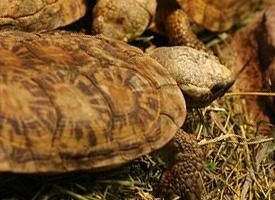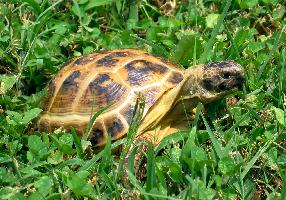
Descrierea animalului
The Pancake tortoise (Malacochersus tornieri) is a unique and fascinating species of tortoise, distinguished by its remarkably flat shell and agile movements, which are atypical characteristics among its more domed and slow-moving relatives. Native to the rocky regions of East Africa, particularly Tanzania and Kenya, this species has adapted to an extraordinary niche that allows it to survive in a challenging environment.Physically, the Pancake tortoise has a soft, flexible shell that is significantly flatter than that of other tortoises, hence its name. The shell's coloration, a blend of brown and tan with patterns that mimic the appearance of the rocks among which it dwells, serves as an effective camouflage. This adaptation not only helps it to avoid predators but also aids in thermoregulation, allowing the tortoise to bask in the sun without overheating. The shell is not just flat but also relatively light and flexible compared to other tortoises, due to reduced bone density and the presence of numerous openings between the bone plates. This flexibility is a critical adaptation for squeezing into narrow crevices between rocks, a behavior that provides protection from predators and extreme weather.
Adult Pancake tortoises typically measure about 15 to 17 centimeters (6 to 7 inches) in length, making them relatively small compared to many other tortoise species. Their limbs are strong and well-adapted for climbing over the rugged terrain of their habitat. Unlike most tortoises, which rely on a strong, domed shell for protection, the Pancake tortoise's speed and agility are its primary defenses against predators. It can quickly scuttle to safety, navigating through tight spaces where predators cannot follow.
The diet of the Pancake tortoise is herbivorous, consisting mainly of grasses, fruits, and succulent plants found in its arid habitat. This diet contributes to the tortoise's relatively low water needs, an important adaptation for survival in dry environments.
Reproduction in Pancake tortoises is a slow process, as females typically lay only one egg at a time, and the incubation period can last several months. The species' slow reproductive rate, combined with threats from habitat destruction and the illegal pet trade, has led to concerns about its long-term survival. The Pancake tortoise is classified as Vulnerable by the International Union for Conservation of Nature (IUCN), indicating that it faces a high risk of extinction in the wild.
Conservation efforts for the Pancake tortoise are focused on habitat protection and the regulation of trade. Programs aimed at educating local communities about the species and its ecological role are crucial for its preservation. Additionally, captive breeding programs have been established to help bolster wild populations and ensure the genetic diversity of this unique species.
In summary, the Pancake tortoise is a remarkable example of adaptation and specialization. Its flat shell, agility, and camouflage capabilities set it apart from other tortoises, making it a unique inhabitant of the rocky landscapes of East Africa. Despite its resilience and adaptability, the species faces significant threats from human activities, highlighting the need for continued conservation efforts to ensure its survival.
Animale similare
Fotografii noi cu animale
Top 10 animale
- Dolphin gull (Leucophaeus scoresbii)
- Diana monkey (Cercopithecus diana)
- Moustached guenon (Cercopithecus cephus)
- Galápagos tortoise (Geochelone nigra complex)
- Japanese macaque (Macaca fuscata)
- Russian tortoise (Testudo horsfieldii)
- Stone loach (Barbatula barbatula)
- Greek tortoise (Testudo graeca)
- Common flying dragon (Draco volans)
- Vendace (Coregonus albula)


